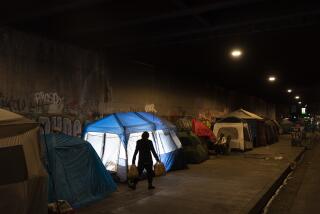Homeowners Defy Law : ‘Graying’ Tints White Areas in South Africa
- Share via
JOHANNESBURG, South Africa — When Ebrahim Kajee, a 61-year-old real estate salesman, moved his family into a large, red-brick home in the tidy suburb of Homestead Park a few weeks ago, one of his neighbors showed up before he had even finished unloading the furniture.
The neighbor, Allen McCabe, advised Kajee, who is classified as Indian under South African law, that the community was for whites only. Then McCabe called the police, who chatted a few minutes with Kajee but left without making a fuss.
McCabe, who has organized his white neighbors to fight the illegal “graying,” was irritated.
“To me, there is a law making this area white and the government is refusing to enforce its own law,” McCabe said later in his living room around the corner from Kajee’s home.
Not a Crusader
Kajee said he bought here “because I liked the house,” not because he wanted to be a crusader. But he added: “I was born and bred in South Africa. I’ve never even been to India. Why shouldn’t I be able to live where I want?”
South African President Pieter W. Botha said early this month that he supports limited changes in the Group Areas Act that would allow neighborhoods the option of opening themselves to all races. The act, a cornerstone of apartheid, has for 37 years divided South Africa into racially separate residential areas.
But thousands of blacks, Indians and mixed-race Coloreds have already moved into some white working-class suburbs of South Africa’s major cities--openly defying the law.
No one knows whether local-option integration would legalize these de facto “open areas” or spur the white residents to militant opposition and the government to mass evictions. But local-option integration already has already created turmoil.
Assailed by Left, Right
McCabe, a 40-year-old carpenter, the father of a teen-age daughter and the coach of a local youth baseball team, said, “One could create a war here if one wanted to.”
Although the changes in the Group Areas Act seem assured, they have come in for harsh criticism from both the political left and right.
Clive Derby-Lewis, part of the government’s right-wing white opposition in Parliament, predicts that the revisions in the law “will be a green light for people of other colors to flood these (white) areas. There will be chaos.”
Helen Suzman, one of the government’s liberal white critics in Parliament, thinks the Group Areas Act should be scrapped altogether. But she says she also foresees “endless upsurges of violent hostility and neighborhood warring over whether to become open or not.”
A liberal group known as Actstop also complains that the government has not gone far enough. The changes will encourage whites to organize and “open the doors to increased racial tensions,” said Cas Coovadia, a spokesman for Actstop, which was formed to fight evictions of blacks and others who have taken up residence, illegally, in white areas.
A few nights ago, McCabe led a group of three dozen middle-aged whites on a march in the adjacent suburb of Mayfair, from a residents’ association meeting (in a whites-only recreation hall) to the local police station, where they presented a petition objecting to “the movement of other race groups into our area.”
As the group walked past the home of Desiree Steyn, an Indian who had moved in a week before, they shouted, “Keep Mayfair white!”
About 60 black, Colored and Indian supporters of Actstop were waiting when the white delegation returned. Police officers stepped between the two groups to avert a confrontation.
McCabe’s group is trying to keep out people such as Dr. Rashid Rajah, who lives nearby in a remodeled beige stucco house with a swimming pool. While his white neighbors marched, the 33-year-old pediatrician took an emergency telephone call and drove to his clinic to check on a pair of newborn twins.
Rajah, his wife and their children, ages 8, 7 and 2, moved into this white neighborhood about four months ago. Their house cost about $42,000, and they have invested an additional $20,000 in renovation.
Tired of Long Drive
They had owned a house in Lenasia, an Indian township about 25 miles southwest of Johannesburg, but Rajah was growing weary of driving to his downtown clinic three or four times a day for medical emergencies.
“To find a legal home, close to my clinic, would have been impossible,” he said.
Rajah considered living in one of the city’s most expensive white northern suburbs, which also would have been illegal. But he settled on Mayfair instead because it was close to the religious school his two daughters attend.
Rajah had to buy the home under a white name. So he formed a company with a white as majority shareholder, which is the most common way to sidestep the Group Areas Act to purchase homes in white areas.
So far, Rajah says, his neighbors have left him alone. But like many of South Africa’s “illegal” residents, he feels a lingering uneasiness.
‘You Feel Insecure’
“I worry,” he said. “There is always a risk. You feel insecure all the time. You never know what’s going to happen to you. You’re always living in limbo. I’m hoping that because so many of us have already moved in, the government will be forced to allow us to stay.”
But he sounded more hopeful than confident, and he added, “I’m sure they could prosecute me if they wanted to.”
A few blocks away, the whites at the residents’ association meeting talked frankly about their opposition to the “infiltration,” as they called it, of residents such as Rajah.
“The government is selling out the white souls,” said Johanna Leask, who has lived in Mayfair for 19 years. “The blacks and Coloreds have their places. Why do they want to move in on top of us?”
“They’re taking our birthright,” complained Johann van Wyk, a 59-year-old Mayfair resident with a thick white-and-gray beard.
Under apartheid, South Africa’s 5 million whites, 25 million blacks, 3 million Coloreds and 1 million Indians must live in separate areas. South Africa’s white minority controls the government and blacks have no vote in national politics.
Few Actually White
Mayfair and Homestead Park sit side by side, a few miles west of downtown Johannesburg. The “graying” is so extensive that fewer than a third of white Mayfair’s 8,000 residents are actually white; some of the white schools in the community have even closed for lack of students.
Among the 100 or so families in Homestead Park, only five are not white. But McCabe thinks the whites will soon be overwhelmed. It is a day he dreads.
“Once the Indians and Colored are in the majority here, they’ll want to send their children to the local school,” he said. “It’s only logical. And once you’ve got mixed schools, well, there it goes. Pretty soon you have one man, one vote and a black majority rule.”
Many of the newcomers to Homestead Park and Mayfair are wealthier than the white residents. Kajee’s house is among the largest in Homestead Park, for example, with four bedrooms and a pool.
The demand for homes in Mayfair and Homestead created by well-to-do Indian and Colored buyers, for example, has actually increased values. Kajee paid $38,000 for his house, giving the previous owner a nice profit.
Black Housing Scarce
Part of the reason is the housing supply. Black South Africans face a shortage of more than 300,000 dwellings, according to government figures. Similar but smaller shortages exist for housing in Indian and Colored areas.
There is a surplus of homes for whites, although lower-priced houses and apartments are more difficult to obtain in white areas.
In high-rise apartment buildings, such as in Hillbrow on the edge of downtown Johannesburg, some landlords have been using the Group Areas Act as an excuse to charge their illegal black tenants three or four times the legal, controlled rent.
About 80% of the residents of Hillbrow, officially classified as a whites-only community, are black. Black residents are so entrenched there, in fact, that “we are no longer fighting just to stay here,” said Sandi Mgidlana, a 38-year-old bank clerk living there. “Now we will begin fighting for integrated schools and recreational facilities.”
President Botha vowed recently to enforce racially separate neighborhoods until the Group Areas Act is amended, which probably will not be sooner than late 1988. But the government has evicted no one this year and the number of blacks, Indians and Coloreds in some middle-class white areas has steadily swelled.
Schools Segregated
Botha, in approving the proposed revisions to the Group Areas Act, stressed that no community would be opened against its wishes and that schools would remain segregated. But many whites in Mayfair and Homestead Park worry that the government will not evict the illegal residents.
Both communities are conducting door-to-door surveys to determine whether there is any support for becoming an open area. McCabe says the survey in Homestead Park is running 15 to 1 in favor of remaining white-only. But he is asking only white residents.
For now, McCabe says, the only way to stop the encroachment is to try to block people on moving day. McCabe has organized an informal network of white residents who let one another know when an “illegal” family is moving into the neighborhood.
McCabe has responded to half a dozen calls in recent months, rushing out to tell Indians, Coloreds and blacks they cannot move in.
Several times the new homeowners or renters have decided on the spot not to move in. On other occasions, McCabe has called the police. Some officers have ordered the movers to stop carrying furniture into the house on the grounds that a law was about to be broken.
Once the family is in, however, McCabe cannot do anything. A judge ruled in a 1983 court case that no one can be evicted under the Group Areas Act unless the government can prove that the person has alternative accommodations in their racial area.
Given the housing shortage, that is nearly impossible to prove.
“I see their point,” McCabe said with a shrug, “but these people didn’t just fall out of the sky. I say they can just go back where they came from.”
More to Read
Sign up for Essential California
The most important California stories and recommendations in your inbox every morning.
You may occasionally receive promotional content from the Los Angeles Times.











